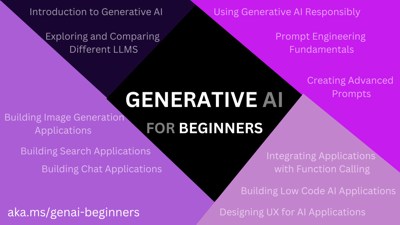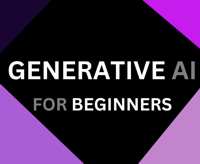| Microsoft's Generative AI for Beginners |
| Written by Nikos Vaggalis | |||
| Tuesday, 21 November 2023 | |||
|
A free, self-paced online course about Generative AI is on offer from Microsoft's Azure Cloud Advocates. It's a 12-lesson curriculum targeted at complete novices to LLMs. We recently looked into some other e-learning offerings such as "The LangChain And Vector Databases in Production" or "LangChain: Chat with Your Data", but these were more advanced courses. This one tackles the concepts from scratch, which you'll explore by building your own Generative AI Startup based on Azure's OpenAI Services. Through it you will get an understanding of what it takes to launch your ideas to the public and profit. As such each lesson covers a key aspect of Generative AI principles and application development. The authors from the beginning draw the live between Machine Learning and Generative AI: Machine Learning - able to learn patterns from data, without being explicitly programmed. This approach allows a machine to simulate human language understanding: a statistical model is trained on text-label pairings, enabling the model to classify unknown input text with a pre-defined label representing the intention of the message. As a subset of Deep Learning, with GenAI you create new written, visual and audio content given prompts or existing data. Large Language Models (LLMs), since they work with textual inputs and outputs – are indeed based on this architecture. The main capability of a Large Language Model is generating a text from scratch, starting from a textual input, written in natural language. The point of the class is to understand how our startup can leverage Large Language Models capabilities to provide a good service to our customers. But in order to do that, we have fisrt to understand that Large Language Models (LLMs) can have multiple categorizations based on their architecture, training data, and use case. Chapter 2 highlights the types of LLMs, and goes through the differences: Text generation Image generation Audio and speech recognition The next chapters utilizes each of them to build a number of applications. But before that, Chapter 3 raise some issues with fairness, bias and harmful content that you should know about in employing LLMs. Bias in Artificial Intelligence is something we have covered many times in our Ethical AI series of articles. For instance in How AI Discriminates examining “Survival of the Best Fit”, we look at an educational game developed by New York University that demonstrates practically how Machine Learning algorithms can make decisions based on bias: . . . so what is the moral of the story? That algorithms are as good as the data they are fed upon and the more biased the data, the more biased the algorithm. Bias parameters can be demographic as in this case due to Google's fictional dataset including more applicants from Orangeville. This led the algorithm to infer that Orangevillers are more valuable than Bluevillers, thus the bias. Other bias parameters that can creep in are gender, ethnicity, age and even your name because it can hint at the other three parameters! With the theory out of the way, we are now ready to become practical. And this begins to happen with Chapters 4 and 5 where we learn how to perform the action of the so called "Prompt Engineering". In Take Vanderbilt's Prompt Engineering for ChatGPT For Free we had looked into the topic and its importance : ChatGPT has been heralded as a tool that can work like a programmer, like a health professional, all the way to like a therapist. The quality of the answers and guidance Prompt Engineering is key to the art of harnessing ChatGPT to help you be more productive in personal and professional life, by finding out how to tweak my inputs to squeeze the best answers out of the bot, on topics of a wide scale. Finally, Chapter 6 is where we start coding, with Python of course, and accessing the Azure OpenAI services. There's some setting up to do first, mainly creating an account, gaining an API key and setting up the development environment. After that we are ready yo code a Recipe generator using the following prompt: "Show me 5 recipes for a dish with the following ingredients: chicken, potatoes, and carrots. Per recipe, list all the ingredients used" Things get more involved in the next chapter, 7, where we build a fully-fledged Chat application, which could give value to our startup by enriching a medical application designed to assist medical practitioners by providing quick references to treatment guidelines, drug interactions, or recent research findings. In the next chapters we learn how to code more example applications depending on the use case:
The final chapter, 12 - Designing UX for AI Applications Each project-based lesson hosts an assignment in order to apply your learning, together with the related code which you can deploy locally or run on the attached Jupyter Notebooks. The course wraps it up by providing a nice list of further resources for continuing your learning on Generative AI. So if until now you were finding it confusing to get started with Generative AI, then confusion begone. Generative AI for beginners is the perfect place to start your journey.
More InformationGenerative AI for Beginners - A Course
Related ArticlesMicrosoft's Artificial Intelligence for Beginners Microsoft's Machine Learning for Beginners Learn To Chat with Your Data For Free Take Vanderbilt's Prompt Engineering for ChatGPT For Free
To be informed about new articles on I Programmer, sign up for our weekly newsletter, subscribe to the RSS feed and follow us on Twitter, Facebook or Linkedin.
Comments
or email your comment to: comments@i-programmer.info |
|||
| Last Updated ( Tuesday, 21 November 2023 ) |



